Unexpected Expansion of Rare-Earth Element Mining Activities in the Myanmar–China Border Region
Abstract
:1. Introduction
2. Materials and Methods
2.1. Study Area
2.2. Geological and Tectonic Setting
2.3. Satellite Data and Image Preprocessing
Classification Scheme and Sampling for Ground Truthing
2.4. Random Forest Classification
2.5. Change Detection
3. Results
3.1. Analysis of Landcover Distribution and Dynamics
3.2. Change Detection Trajectories
3.3. Surface Mining Extent Changes
Comparison of the Results from Mining Sites with High-Resolution Google Earth Images
4. Discussion
Characterization of Rare Earth Mining Extents and Related Social and Environmental Impacts
5. Conclusions
Author Contributions
Funding
Data Availability Statement
Acknowledgments
Conflicts of Interest
References
- Wu, B.; Fang, C.; Yu, L.; Huang, X.; Zhang, Q. A Fully Automatic Method to Extract Rare Earth Mining Areas from Landsat Images. Photogramm. Eng. Remote Sens. 2016, 82, 729–737. [Google Scholar] [CrossRef]
- Muavhi, N.; Mavhungu, M.E.; Ndivhudzannyi, R. Mapping of potential rare earth deposits in the Schiel alkaline complex using sentinel-2B multispectral sensor. Egypt. J. Remote Sens. Space Sci. 2021, 24, 609–617. [Google Scholar] [CrossRef]
- Haque, N.; Hughes, A.; Lim, S.; Vernon, C. Rare Earth Elements: Overview of Mining, Mineralogy, Uses, Sustainability and Environmental Impact. Resources 2014, 3, 614–635. [Google Scholar] [CrossRef]
- Nguyen, R.T.; Imholte, D.D. China’s Rare Earth Supply Chain: Illegal Production, and Response to new Cerium Demand. JOM 2016, 68, 1948–1956. [Google Scholar] [CrossRef]
- Schlinkert, D.; Boogaart, K.G.v.D. The development of the market for rare earth elements: Insights from economic theory. Resour. Policy 2015, 46, 272–280. [Google Scholar] [CrossRef]
- The White House, United States of America. 31 CFR Part 525—Burma Sanctions Regulations. Available online: https://www.ecfr.gov/current/title-31/subtitle-B/chapter-V/part-525 (accessed on 28 March 2023).
- Chen, S. ‘The Sacrifice Zone’: Myanmar Bears Cost of Green Energy|AP News. Available online: https://apnews.com/article/technology-forests-myanmar-75df22e8d7431a6757ea4a426fbde94c (accessed on 28 March 2023).
- Institute for Energy Research. China and the Rare Earth Supply Chain. IER. 23 February 2021. Available online: https://www.instituteforenergyresearch.org/renewable/china-and-the-rare-earth-supply-chain-policy-brief/ (accessed on 28 March 2023).
- Xie, L.; Wu, W.; Huang, X.; Ou, P.; Lin, Z.; Zhiling, W.; Song, Y.; Lang, T.; Huangfu, W.; Zhang, Y.; et al. Mining and Restoration Monitoring of Rare Earth Element (REE) Exploitation by New Remote Sensing Indicators in Southern Jiangxi, China. Remote Sens. 2020, 12, 3558. [Google Scholar] [CrossRef]
- Haq, I.U.; Ferreira, P.; Maneengam, A.; Wisetsri, W. Rare Earth Market, Electric Vehicles and Future Mobility Index: A Time-Frequency Analysis with Portfolio Implications. Risks 2022, 10, 137. [Google Scholar] [CrossRef]
- Silva, M.P.d.S.; Câmara, G.; Escada, M.I.S.; de Souza, R.C.M. Remote-sensing image mining: Detecting agents of land-use change in tropical forest areas. Int. J. Remote Sens. 2008, 29, 4803–4822. [Google Scholar] [CrossRef]
- Zhang, M.; He, T.; Li, G.; Xiao, W.; Song, H.; Lu, D.; Wu, C. Continuous Detection of Surface-Mining Footprint in Copper Mine Using Google Earth Engine. Remote Sens. 2021, 13, 4273. [Google Scholar] [CrossRef]
- Soni, A.K. Estimation of Mine Water Quantity: Development of Guidelines for Indian Mines. Mine Water Environ. 2020, 39, 397–406. [Google Scholar] [CrossRef]
- Nascimento, F.S.; Gastauer, M.; Souza-Filho, P.W.M.; Nascimento, W.R.; Santos, D.C.; Costa, M.F. Land Cover Changes in Open-Cast Mining Complexes Based on High-Resolution Remote Sensing Data. Remote Sens. 2020, 12, 611. [Google Scholar] [CrossRef]
- Luo, P.; Han, X.; Chen, N. Study on Complexity Planning Model of Pumped Storage in Abandoned Open-Pit Mine: A Case Study of Fushun Open-Pit Mine. Front. Earth Sci. 2022, 10, 808371. [Google Scholar] [CrossRef]
- Page, W.R.; VanSistine, D.P.; Turner, K.J. Preliminary Geologic Map of Southernmost Texas, United States, and Parts of Tamaulipas and Nuevo Leon, Mexico: Environmental Health Investigations in the United States-Mexico Border Region; U.S. Geological Survey: Denver, CO, USA, 2005. Available online: https://pubs.usgs.gov/of/2005/1409/ (accessed on 21 August 2023).
- Rubbers, B. Inside Mining Capitalism: The Micropolitics of Work on the Congolese and Zambian Copperbelts; Boydell & Brewer: Suffolk, UK, 2021. [Google Scholar] [CrossRef]
- Chaussard, E.; Kerosky, S. Characterization of Black Sand Mining Activities and Their Environmental Impacts in the Philippines Using Remote Sensing. Remote Sens. 2016, 8, 100. [Google Scholar] [CrossRef]
- Mimouni, M.E.; Aarab, A.; Lakhloufi, A.; Hamzaoui, A.; Benammi, E.M.; Benyas, K. New Targets of Potential Mining Interest Using Gravimetric and Satellite Data: Case Study of Hercynian Rehamna Massif, Morocco. Iraqi Geol. J. 2022, 55, 14–26. [Google Scholar] [CrossRef]
- Brown, C.; Boyd, D.S.; Kara, S. Landscape Analysis of Cobalt Mining Activities from 2009 to 2021 Using Very High Resolution Satellite Data (Democratic Republic of the Congo). Sustainability 2022, 14, 9545. [Google Scholar] [CrossRef]
- Zhiqiang, L.; Peihong, L.; Yimin, Y. Research on Multi-scale Segmentation of Remote Sensing Images of Typical Feature in Rare Earth Mining Area. IOP Conf. Ser. Earth Environ. Sci. 2021, 671, 012025. [Google Scholar] [CrossRef]
- Vorovencii, I. Changes detected in the extent of surface mining and reclamation using multitemporal Landsat imagery: A case study of Jiu Valley, Romania. Environ. Monit. Assess. 2021, 193, 30. [Google Scholar] [CrossRef]
- Juanda, E.T.; Martono, D.N.; Saria, L. Analysis vegetation change on coal mine reclamation using Normalized Difference Vegetation Index (NDVI). IOP Conf. Ser. Earth Environ. Sci. 2021, 716, 012035. [Google Scholar] [CrossRef]
- Basommi, P.L.; Guan, Q.; Cheng, D. Exploring Land use and Land cover change in themining areas of Wa East District, Ghana usingSatellite Imagery. Open Geosci. 2015, 7, 20150058. [Google Scholar] [CrossRef]
- Li, H.; Wu, L.; Liu, X. Change detection of ground-surface environment in rare earth mining area based on multi-temporal remote sensing: A case in Lingbei rare earth mining area. Zhongguo Kuangye Daxue Xuebao J. China Univ. Min. Technol. 2014, 43, 1087–1094. [Google Scholar]
- Rawat, J.; Kumar, M. Monitoring land use/cover change using remote sensing and GIS techniques: A case study of Hawalbagh block, district Almora, Uttarakhand, India. Egypt. J. Remote Sens. Space Sci. 2015, 18, 77–84. [Google Scholar] [CrossRef]
- Arıkan, C.; Tümer, İ.N.; Aksoy, S.; Sertel, E. Determination of burned areas using Sentinel-2A imagery and machine learning classification algorithms. Intercont. Geoinf. Days 2022, 4, 43–46. [Google Scholar]
- Korytkowski, M.; Rutkowski, L.; Scherer, R. Fast image classification by boosting fuzzy classifiers. Inf. Sci. 2016, 327, 175–182. [Google Scholar] [CrossRef]
- Sanghvi, K.; Aralkar, A.; Sanghvi, S.; Saha, I. A Survey on Image Classification Techniques. SSRN Electron. J. 2021. [Google Scholar] [CrossRef]
- Breiman, L. Random forests. Mach. Learn. 2001, 45, 5–32. [Google Scholar] [CrossRef]
- Naushad, R.; Kaur, T.; Ghaderpour, E. Deep Transfer Learning for Land Use and Land Cover Classification: A Comparative Study. Sensors 2021, 21, 8083. [Google Scholar] [CrossRef]
- Alzubaidi, L.; Zhang, J.; Humaidi, A.J.; Al-Dujaili, A.; Duan, Y.; Al-Shamma, O.; Santamaría, J.; Fadhel, M.A.; Al-Amidie, M.; Farhan, L. Review of deep learning: Concepts, CNN architectures, challenges, applications, future directions. J. Big Data 2021, 8, 53. [Google Scholar] [CrossRef]
- Thanh Noi, P.; Kappas, M. Comparison of Random Forest, k-Nearest Neighbor, and Support Vector Machine Classifiers for Land Cover Classification Using Sentinel-2 Imagery. Sensors 2018, 18, 18. [Google Scholar] [CrossRef]
- Khelifi, L.; Mignotte, M. Deep Learning for Change Detection in Remote Sensing Images: Comprehensive Review and Meta-Analysis. IEEE Access 2020, 8, 126385–126400. [Google Scholar] [CrossRef]
- Gorelick, N.; Hancher, M.; Dixon, M.; Ilyushchenko, S.; Thau, D.; Moore, R. Google Earth Engine: Planetary-scale geospatial analysis for everyone. Remote Sens. Environ. 2017, 202, 18–27. [Google Scholar] [CrossRef]
- Bahşi, K.; Ustaoglu, B.; Aksoy, S.; Sertel, E. Estimation of emissions from crop residue burning in Türkiye using remotely sensed data and the Google Earth Engine platform. Geocarto Int. 2022, 38, 2157052. [Google Scholar] [CrossRef]
- Huang, H.; Chen, Y.; Clinton, N.; Wang, J.; Wang, X.; Liu, C.; Gong, P.; Yang, J.; Bai, Y.; Zheng, Y.; et al. Mapping major land cover dynamics in Beijing using all Landsat images in Google Earth Engine. Remote Sens. Environ. 2017, 202, 166–176. [Google Scholar] [CrossRef]
- Bayrakdar, H.Y.; Kavlak, M.; Yilmazel, B.; Çabuk, A. Assessing the performance of machine learning algorithms in Google Earth Engine for land use and land cover analysis: A case study of Muğla province, Türkiye. J. Des. Resil. Arch. Plan. 2022, 3, 224–236. [Google Scholar] [CrossRef]
- Woods, K. Expansion of Agribusiness in Myanmar: Driver of deforestation, conversion timber and land conflicts in Myanmar. 2015. Available online: https://www.forest-trends.org/publications/commercial-agriculture-expansion-in-myanmar-links-to-deforestation-conversion-timber-and-land-conflicts/ (accessed on 29 March 2023).
- Ting, Z. A Study of the Impacts of Shifting Cultivation on the Environment and Local People in Kachin State, Myanmar. 2014. Available online: https://www.academia.edu/49165530/A_Study_of_the_Impacts_of_Shifting_Cultivation_on_the_Environment_and_Local_People_in_Kachin_State_Myanmar (accessed on 29 March 2023).
- Sun, H.; Wang, J.; Xiong, J.; Bian, J.; Jin, H.; Cheng, W.; Li, A. Vegetation Change and Its Response to Climate Change in Yunnan Province, China. Adv. Meteorol. 2021, 2021, 8857589. [Google Scholar] [CrossRef]
- Ranjitkar, S.; Sujakhu, N.M.; Lu, Y.; Wang, Q.; Wang, M.; He, J.; Mortimer, P.E.; Xu, J.; Kindt, R.; Zomer, R.J. Climate modelling for agroforestry species selection in Yunnan Province, China. Environ. Model. Softw. 2016, 75, 263–272. [Google Scholar] [CrossRef]
- Zomer, R.J.; Xu, J.; Wang, M.; Trabucco, A.; Li, Z. Projected impact of climate change on the effectiveness of the existing protected area network for biodiversity conservation within Yunnan Province, China. Biol. Conserv. 2015, 184, 335–345. [Google Scholar] [CrossRef]
- Licht, A.; Dupont-Nivet, G.; Win, Z.; Swe, H.H.; Kaythi, M.; Roperch, P.; Ugrai, T.; Littell, V.; Park, D.; Westerweel, J.; et al. Paleogene evolution of the Burmese forearc basin and implications for the history of India-Asia convergence. GSA Bull. 2018, 131, 730–748. [Google Scholar] [CrossRef]
- The Geology of Burma (Myanmar): An Annotated Bibliography of Burma’s Geology, Geography and Earth Science. Available online: https://www.researchgate.net/publication/235104805_The_Geology_of_Burma_Myanmar_An_Annotated_Bibliography_of_Burma’s_Geology_Geography_and_Earth_Science (accessed on 12 January 2023).
- Barber, T. Book Review. Am. Miner. 2020, 105, 287–288. [Google Scholar] [CrossRef]
- Westerweel, J.; Roperch, P.; Licht, A.; Dupont-Nivet, G.; Win, Z.; Poblete, F.; Ruffet, G.; Swe, H.H.; Thi, M.K.; Aung, D.W. Burma Terrane part of the Trans-Tethyan arc during collision with India according to palaeomagnetic data. Nat. Geosci. 2019, 12, 863–868. [Google Scholar] [CrossRef]
- Searle, M.P.; Morley, C.K.; Waters, D.J.; Gardiner, N.J.; Htun, U.K.; Nu, T.T.; Robb, L.J. Chapter 12 Tectonic and metamorphic evolution of the Mogok Metamorphic and Jade Mines belts and ophiolitic terranes of Burma (Myanmar). Geol. Soc. Lond. Mem. 2017, 48, 261–293. [Google Scholar] [CrossRef]
- Parlak, O.; Delaloye, M.; Bíngöl, E. Mineral chemistry of ultramafic and mafic cumulates as an indicator of the arc-related origin of the Mersin ophiolite (southern Turkey). Int. J. Earth Sci. 1996, 85, 647–661. [Google Scholar] [CrossRef]
- Liu, T.; Liu, C.; Chen, Y.; Guo, S.; Sein, K.; Dong, X. Petrology and geochemistry of ultramafic rocks in the Mogok belt, Myanmar: Cumulates from high-pressure crystallization of hydrous arc melts. Geol. J. 2021, 57, 886–905. [Google Scholar] [CrossRef]
- Karimzadeh, S.; Tangestani, M.H. Potential of Sentinel-2 MSI data in targeting rare earth element (Nd3+) bearing minerals in Esfordi phosphate deposit, Iran. Egypt. J. Remote Sens. Space Sci. 2022, 25, 697–710. [Google Scholar] [CrossRef]
- Lavenir, N.M.J.; Cyrille, S.; Paul, N.J.; Suh, C.E. Mineral chemistry (EMPA) of monazites in metamorphic rocks from Edea region: Implications of the monazite chemistry on the metamorphic evolution of the Nyong Complex. Arab. J. Geosci. 2022, 15, 1665. [Google Scholar] [CrossRef]
- Purwadi, I.; van der Werff, H.; Lievens, C. Targeting rare earth element bearing mine tailings on Bangka Island, Indonesia, with Sentinel-2 MSI. Int. J. Appl. Earth Obs. Geoinf. 2020, 88, 102055. [Google Scholar] [CrossRef]
- Kokaly, R.F.; Clark, R.N.; Swayze, G.A.; Livo, K.E.; Hoefen, T.M.; Pearson, N.C.; Wise, R.A.; Benzel, W.M.; Lowers, H.A.; Driscoll, R.L.; et al. USGS Spectral Library Version 7; U.S. Geological Survey: Reston, VA, USA, 2017; 61p. [Google Scholar] [CrossRef]
- Ditian; Devy, M.; Eko, W.; Sanjaya, H.; Hartono, R. Mangrove Extent and Change Mapping of Muaragembong from 1990 to 2020 using Google Earth Engine (GEE). In Proceedings of the IEEE Ocean Engineering Technology and Innovation Conference: Ocean Observation, Technology and Innovation in Support of Ocean Decade of Science (OETIC), Jakarta, Indonesia, 8–9 November 2021; Sanjaya, H., Ed.; pp. 35–38. [Google Scholar] [CrossRef]
- Liu, Y.; Xie, M.; Liu, J.; Wang, H.; Chen, B. Vegetation Disturbance and Recovery Dynamics of Different Surface Mining Sites via the LandTrendr Algorithm: Case Study in Inner Mongolia, China. Land 2022, 11, 856. [Google Scholar] [CrossRef]
- Ma, C.; Guo, Z.-Z.; Zhang, X.-K.; Han, R.-M. Annual integral changes of time serial NDVI in mining subsidence area. Trans. Nonferrous Met. Soc. China 2011, 21, s583–s588. [Google Scholar] [CrossRef]
- Rouse, J.W.; Haas, R.H.; Schell, J.A.; Deering, D.W. Monitoring vegetation systems in the Great Plains with ERTS. In Third Earth Resources Technology Satellite-1 Symposium; NASA Sp-351 I: Greenbelt, MA, USA, 1973; Volume 351, pp. 309–317. [Google Scholar]
- Fan, X.; Guan, Y.; Bai, Z.; Zhou, W.; Zhu, C. Optimization of Reclamation Measures in a Mining Area by Analysis of Variations in Soil Nutrient Grades under Different Types of Land Usage—A Case Study of Pingshuo Coal Mine, China. Land 2022, 11, 321. [Google Scholar] [CrossRef]
- Liu, X.; Cao, Y.; Bai, Z.; Wang, J.; Zhou, W. Evaluating relationships between soil chemical properties and vegetation cover at different slope aspects in a reclaimed dump. Environ. Earth Sci. 2017, 76, 805. [Google Scholar] [CrossRef]
- China-led Rare Earth Mining in Myanmar Fuels Rights Abuses, Pollution: Report. Radio Free Asia. Available online: https://www.rfa.org/english/news/myanmar/rareearths-08092022183340.html (accessed on 4 April 2023).
- Hansen, M.C.; Roy, D.P.; Lindquist, E.; Adusei, B.; Justice, C.O.; Altstatt, A. A method for integrating MODIS and Landsat data for systematic monitoring of forest cover and change in the Congo Basin. Remote Sens. Environ. 2008, 112, 2495–2513. [Google Scholar] [CrossRef]
- Rabiei-Dastjerdi, H.; Amini, S.; McArdle, G.; Homayouni, S. City-region or city? That is the question: Modelling sprawl in Isfahan using geospatial data and technology. GeoJournal 2022. [Google Scholar] [CrossRef]
- Zhu, Z.; Zhang, Z.; Zuo, L.; Pan, T.; Zhao, X.; Wang, X.; Sun, F.; Xu, J.; Liu, Z. Study on the Classification and Change Detection Methods of Drylands in Arid and Semi-Arid Regions. Remote Sens. 2022, 14, 1256. [Google Scholar] [CrossRef]
- Amini, S.; Saber, M.; Rabiei-Dastjerdi, H.; Homayouni, S. Urban Land Use and Land Cover Change Analysis Using Random Forest Classification of Landsat Time Series. Remote Sens. 2022, 14, 2654. [Google Scholar] [CrossRef]
- Zhai, H.; Lv, C.; Liu, W.; Yang, C.; Fan, D.; Wang, Z.; Guan, Q. Understanding Spatio-Temporal Patterns of Land Use/Land Cover Change under Urbanization in Wuhan, China, 2000–2019. Remote Sens. 2021, 13, 3331. [Google Scholar] [CrossRef]
- Tu, Y.; Chen, B.; Zhang, T.; Xu, B. Regional Mapping of Essential Urban Land Use Categories in China: A Segmentation-Based Approach. Remote Sens. 2020, 12, 1058. [Google Scholar] [CrossRef]
- Pal, M. Random forest classifier for remote sensing classification. Int. J. Remote Sens. 2005, 26, 217–222. [Google Scholar] [CrossRef]
- Somayajula, V.K.; Ghai, D.; Kumar, S. Land Use/Land Cover Change Analysis Using NDVI, PCA. In Proceedings of the 5th International Conference on Computing Methodologies and Communication (ICCMC), Erode, India, 8–10 April 2021; pp. 849–855. [Google Scholar] [CrossRef]
- Madanian, M.; Soffianian, A.R.; Koupai, S.S.; Pourmanafi, S.; Momeni, M. Analyzing the effects of urban expansion on land surface temperature patterns by landscape metrics: A case study of Isfahan city, Iran. Environ. Monit. Assess. 2018, 190, 189. [Google Scholar] [CrossRef]
- Mantero, P.; Moser, G.; Serpico, S. Partially Supervised classification of remote sensing images through SVM-based probability density estimation. IEEE Trans. Geosci. Remote Sens. 2005, 43, 559–570. [Google Scholar] [CrossRef]
- Wulder, M.A.; Li, Z.; Campbell, E.M.; White, J.C.; Hobart, G.; Hermosilla, T.; Coops, N.C. A National Assessment of Wetland Status and Trends for Canada’s Forested Ecosystems Using 33 Years of Earth Observation Satellite Data. Remote Sens. 2018, 10, 1623. [Google Scholar] [CrossRef]
- Lechner, M.; Dostálová, A.; Hollaus, M.; Atzberger, C.; Immitzer, M. Combination of Sentinel-1 and Sentinel-2 Data for Tree Species Classification in a Central European Biosphere Reserve. Remote Sens. 2022, 14, 2687. [Google Scholar] [CrossRef]
- Tamiminia, H.; Salehi, B.; Mahdianpari, M.; Quackenbush, L.; Adeli, S.; Brisco, B. Google Earth Engine for geo-big data applications: A meta-analysis and systematic review. ISPRS J. Photogramm. Remote Sens. 2020, 164, 152–170. [Google Scholar] [CrossRef]
- Rudiastuti, A.W.; Lumban-Gaol, Y.; Silalahi, F.E.S.; Prihanto, Y.; Pranowo, W.S. Implementing Random Forest Algorithm in GEE: Separation and Transferability on Built-Up Area in Central Java, Indonesia. JOIV Int. J. Inform. Vis. 2022, 6, 74–82. [Google Scholar] [CrossRef]
- Maxwell, A.E.; Warner, T.A.; Fang, F. Implementation of machine-learning classification in remote sensing: An applied review. Int. J. Remote Sens. 2018, 39, 2784–2817. [Google Scholar] [CrossRef]
- Phan, T.N.; Kuch, V.; Lehnert, L.W. Land Cover Classification using Google Earth Engine and Random Forest Classifier—The Role of Image Composition. Remote Sens. 2020, 12, 2411. [Google Scholar] [CrossRef]
- He, H.; Garcia, E.A. Learning from Imbalanced Data. IEEE Trans. Knowl. Data Eng. 2009, 21, 1263–1284. [Google Scholar] [CrossRef]
- Więckowska, B.; Kubiak, K.B.; Jóźwiak, P.; Moryson, W.; Stawińska-Witoszyńska, B. Cohen’s Kappa Coefficient as a Measure to Assess Classification Improvement following the Addition of a New Marker to a Regression Model. Int. J. Environ. Res. Public Health 2022, 19, 10213. [Google Scholar] [CrossRef]
- de Raadt, A.; Warrens, M.J.; Bosker, R.J.; Kiers, H.A.L. A Comparison of Reliability Coefficients for Ordinal Rating Scales. J. Classif. 2021, 38, 519–543. [Google Scholar] [CrossRef]
- Meier, J.; Mauser, W. Irrigation Mapping at Different Spatial Scales: Areal Change with Resolution Explained by Landscape Metrics. Remote Sens. 2023, 15, 315. [Google Scholar] [CrossRef]
- Zhang, C.; Dong, J.; Zuo, L.; Ge, Q. Tracking spatiotemporal dynamics of irrigated croplands in China from 2000 to 2019 through the synergy of remote sensing, statistics, and historical irrigation datasets. Agric. Water Manag. 2022, 263, 107458. [Google Scholar] [CrossRef]
- Panuju, D.R.; Paull, D.J.; Griffin, A.L. Change Detection Techniques Based on Multispectral Images for Investigating Land Cover Dynamics. Remote Sens. 2020, 12, 1781. [Google Scholar] [CrossRef]
- Reis, M.S.; Dutra, L.V.; Sant’anna, S.J.S.; Escada, M.I.S. Examining Multi-Legend Change Detection in Amazon with Pixel and Region Based Methods. Remote Sens. 2017, 9, 77. [Google Scholar] [CrossRef]
- Baig, M.F.; Mustafa, M.R.U.; Baig, I.; Takaijudin, H.B.; Zeshan, M.T. Assessment of Land Use Land Cover Changes and Future Predictions Using CA-ANN Simulation for Selangor, Malaysia. Water 2022, 14, 402. [Google Scholar] [CrossRef]
- Rakhmangulov, A.; Burmistrov, K.; Osintsev, N. Selection of Open-Pit Mining and Technical System’s Sustainable Development Strategies Based on MCDM. Sustainability 2022, 14, 8003. [Google Scholar] [CrossRef]
- Zhou, Y.; Zhou, W.; Lu, X.; Jiskani, I.M.; Cai, Q.; Liu, P.; Li, L. Evaluation Index System of Green Surface Mining in China. Mining, Metall. Explor. 2020, 37, 1093–1103. [Google Scholar] [CrossRef]
- Dutta, T.; Kim, K.-H.; Uchimiya, M.; Kwon, E.E.; Jeon, B.-H.; Deep, A.; Yun, S.-T. Global demand for rare earth resources and strategies for green mining. Environ. Res. 2016, 150, 182–190. [Google Scholar] [CrossRef]
- LaJeunesse Connette, K.J.; Connette, G.; Bernd, A.; Phyo, P.; Aung, K.H.; Tun, Y.L.; Thein, Z.M.; Horning, N.; Leimgruber, P.; Songer, M. Assessment of Mining Extent and Expansion in Myanmar Based on Freely-Available Satellite Imagery. Remote Sens. 2016, 8, 912. [Google Scholar] [CrossRef]
- Dlamini, L.Z.D.; Xulu, S. Monitoring Mining Disturbance and Restoration over RBM Site in South Africa Using LandTrendr Algorithm and Landsat Data. Sustainability 2019, 11, 6916. [Google Scholar] [CrossRef]
- D’Souza, K. Artisanal Mining in the DRC: Key Issues, Challenges and Opportunities; Communities and Small-Scale Mining; World Bank: Washington, DC, USA, 2007; Available online: https://delvedatabase.org/uploads/resources/2007_CASM_DSouza_DRC-Artisianal-Mining-Key-Issues-Challenges-Opportunities.pdf (accessed on 4 April 2023).
- Klinger, J.M. Social and Environmental Impacts of Rare Earth Mining, Processing, and Proliferation: Scoping and Preliminary Assessment. In Critical Minerals, the Climate Crisis and the Tech Imperium; Kalantzakos, S., Ed.; Springer Nature Switzerland: Cham, Switzerland, 2023; pp. 149–165. [Google Scholar] [CrossRef]
- Rare Earths in Myanmar: Unobtanium? Available online: https://thediplomat.com/2021/06/rare-earths-in-myanmar-unobtanium/ (accessed on 4 April 2023).
- Zapp, P.; Schreiber, A.; Marx, J.; Kuckshinrichs, W. Environmental impacts of rare earth production. MRS Bull. 2022, 47, 267–275. [Google Scholar] [CrossRef]
- Nakano, J. The Geopolitics of Critical Minerals Supply Chains. 2021. Available online: https://www.csis.org/analysis/geopolitics-critical-minerals-supply-chains (accessed on 1 May 2023).
- Sophia, K. The Geopolitics of Critical Minerals. Professional Paper. 2017. Available online: https://www.academia.edu/41546280/The_Geopolitics_of_Critical_Minerals (accessed on 8 May 2023).
- Klinger, J.M. Rare Earth Frontiers: From Terrestrial Subsoils to Lunar Landscapes; Illustrated Edition; Cornell University Press: Ithaca, NY, USA, 2018. [Google Scholar]
- Balaram, V. Potential Future Alternative Resources for Rare Earth Elements: Opportunities and Challenges. Minerals 2023, 13, 425. [Google Scholar] [CrossRef]
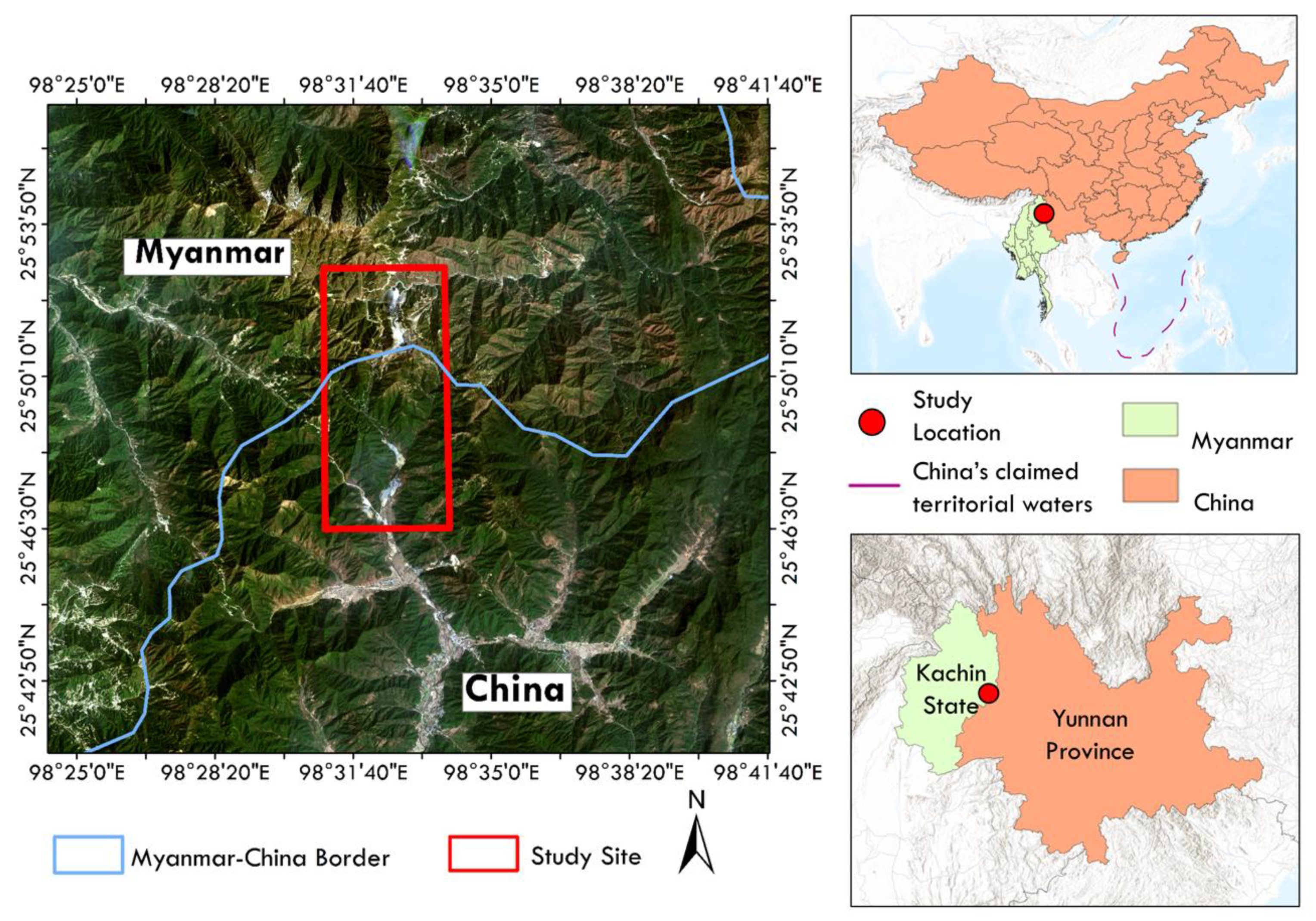
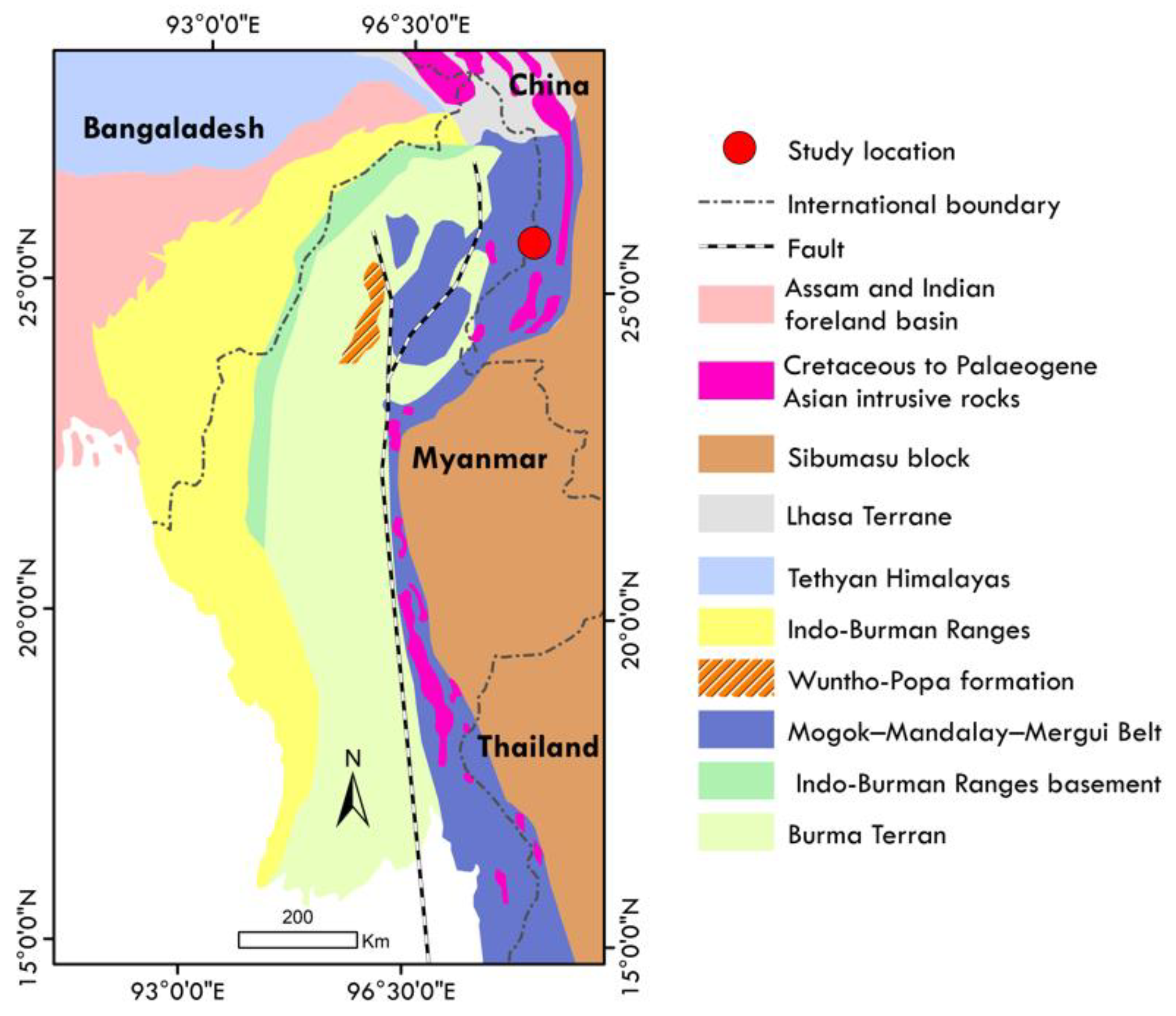
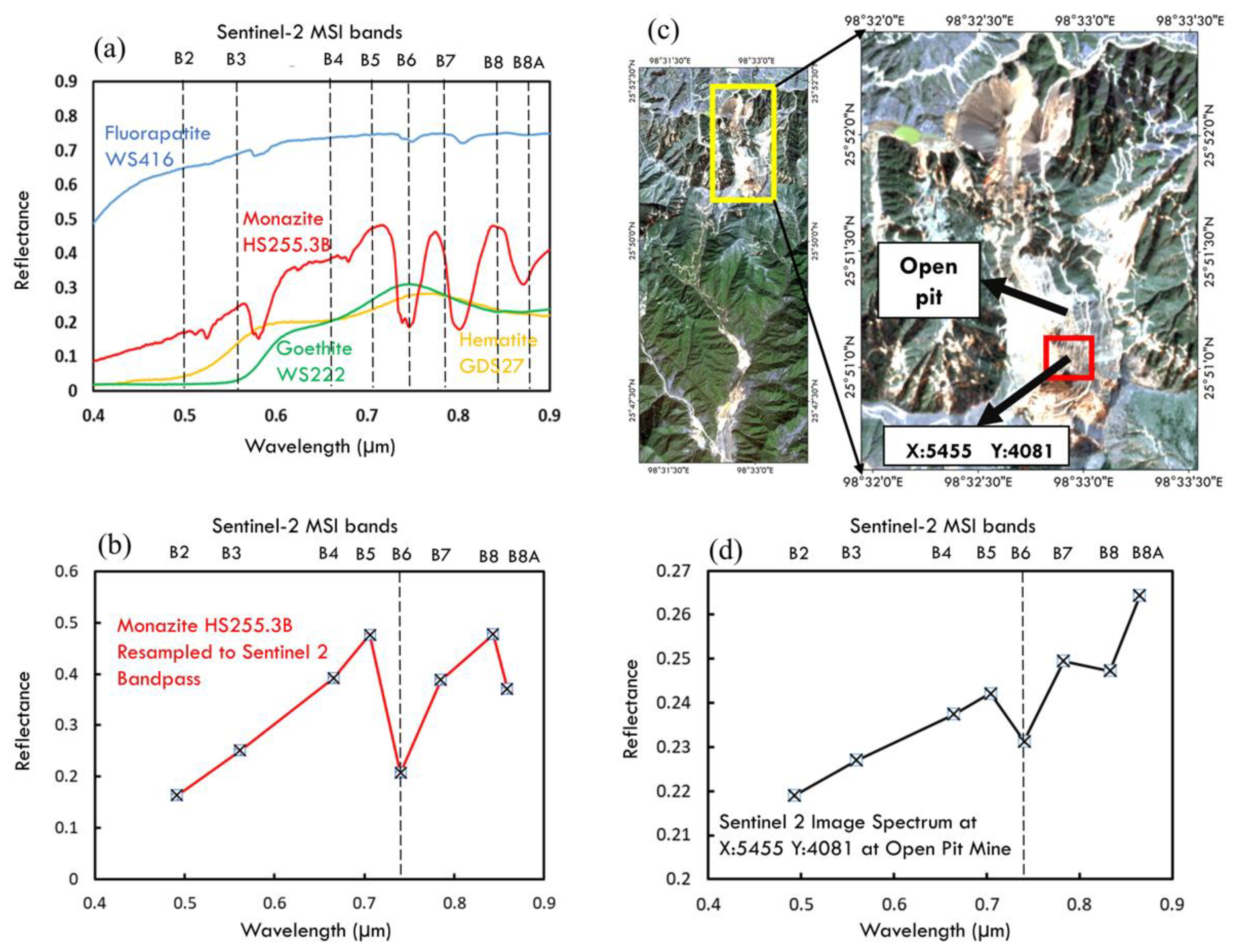
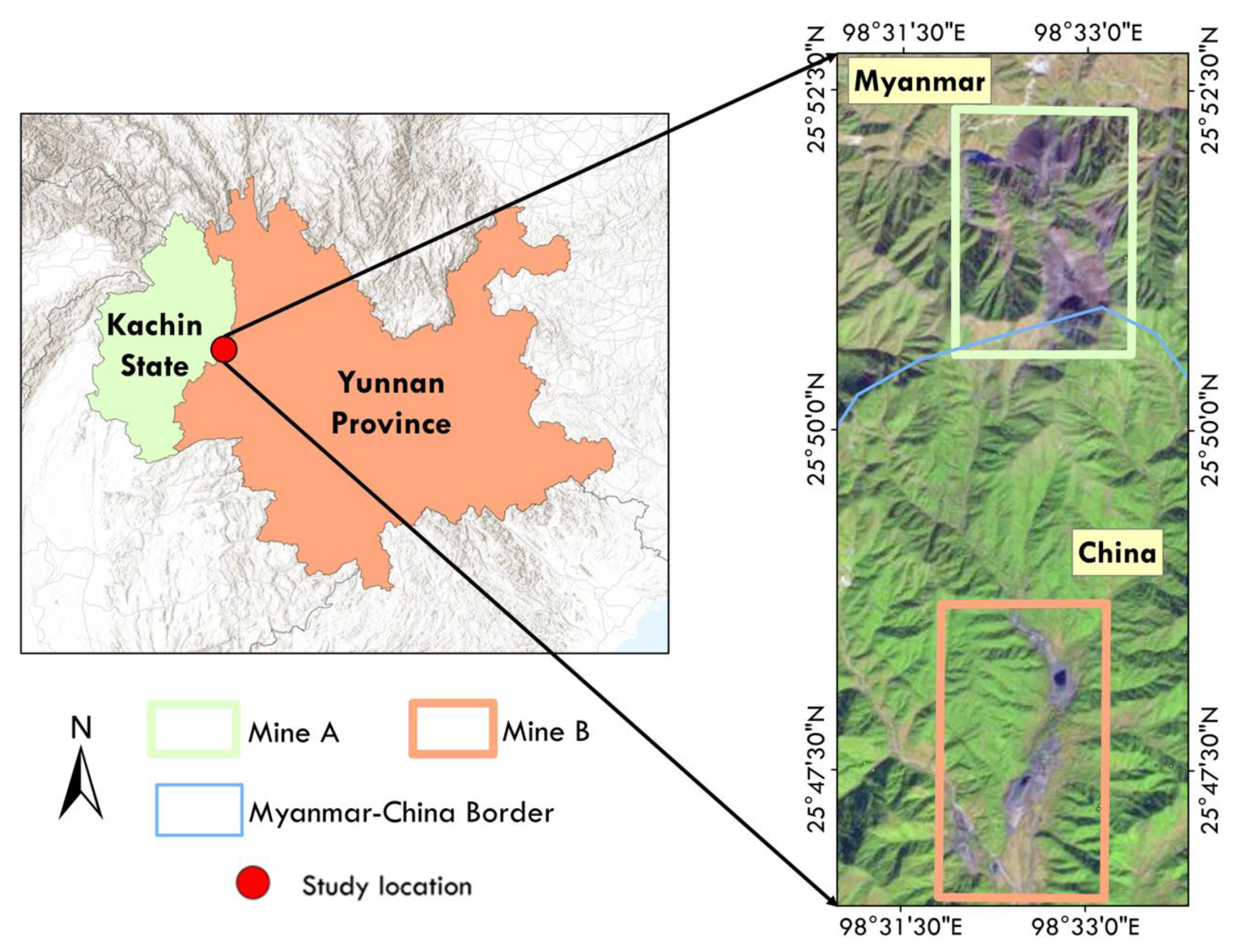
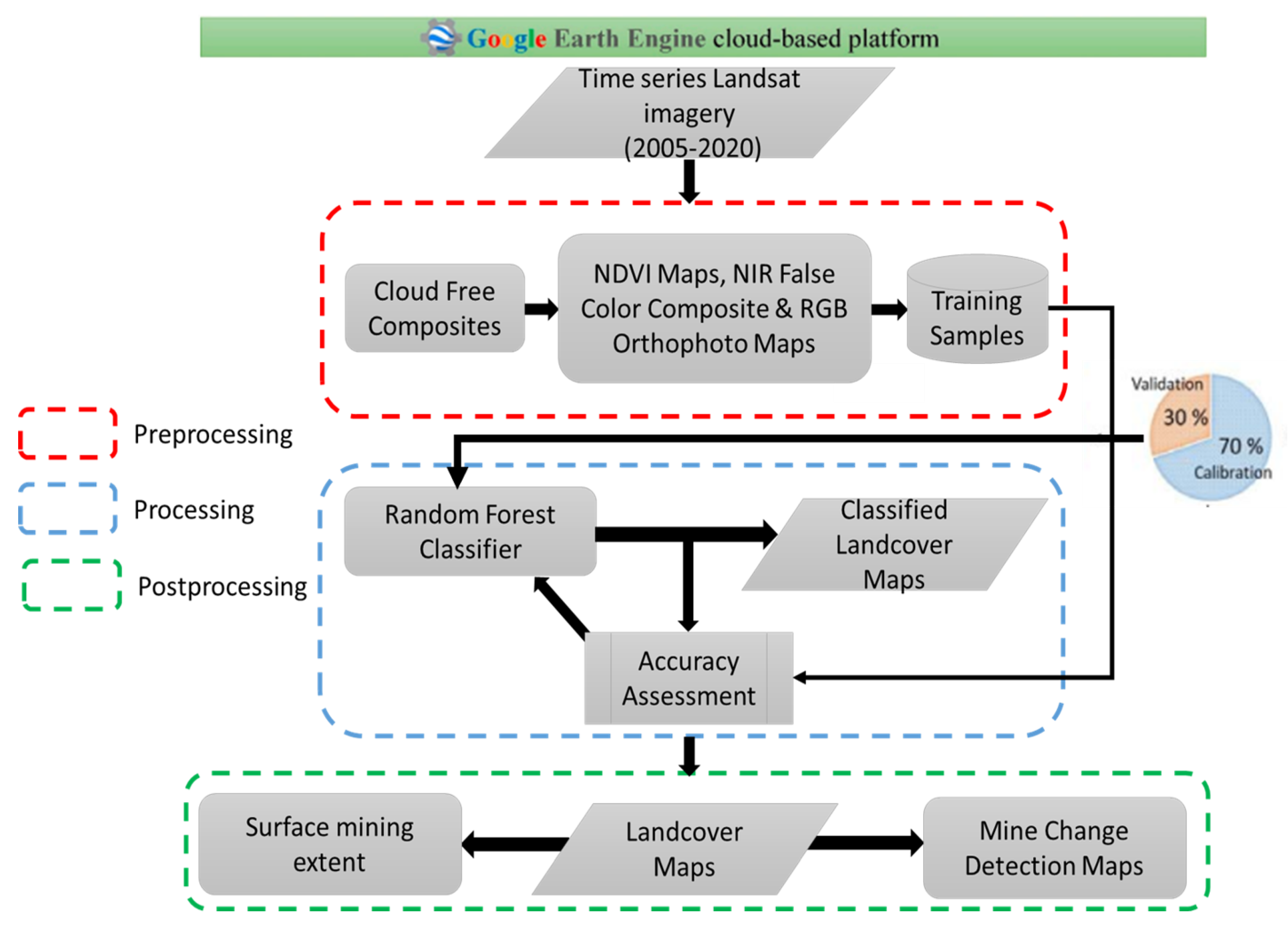



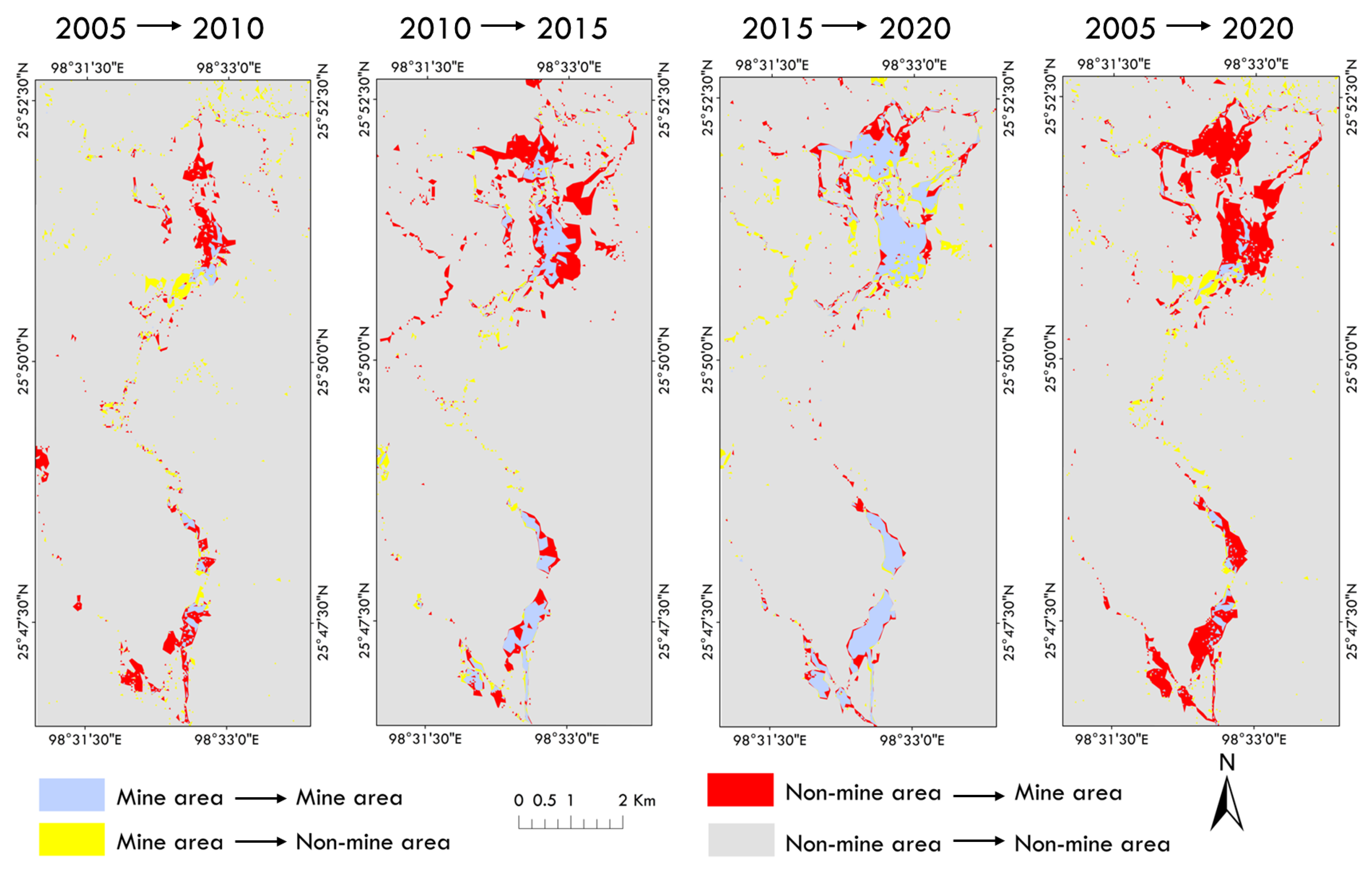

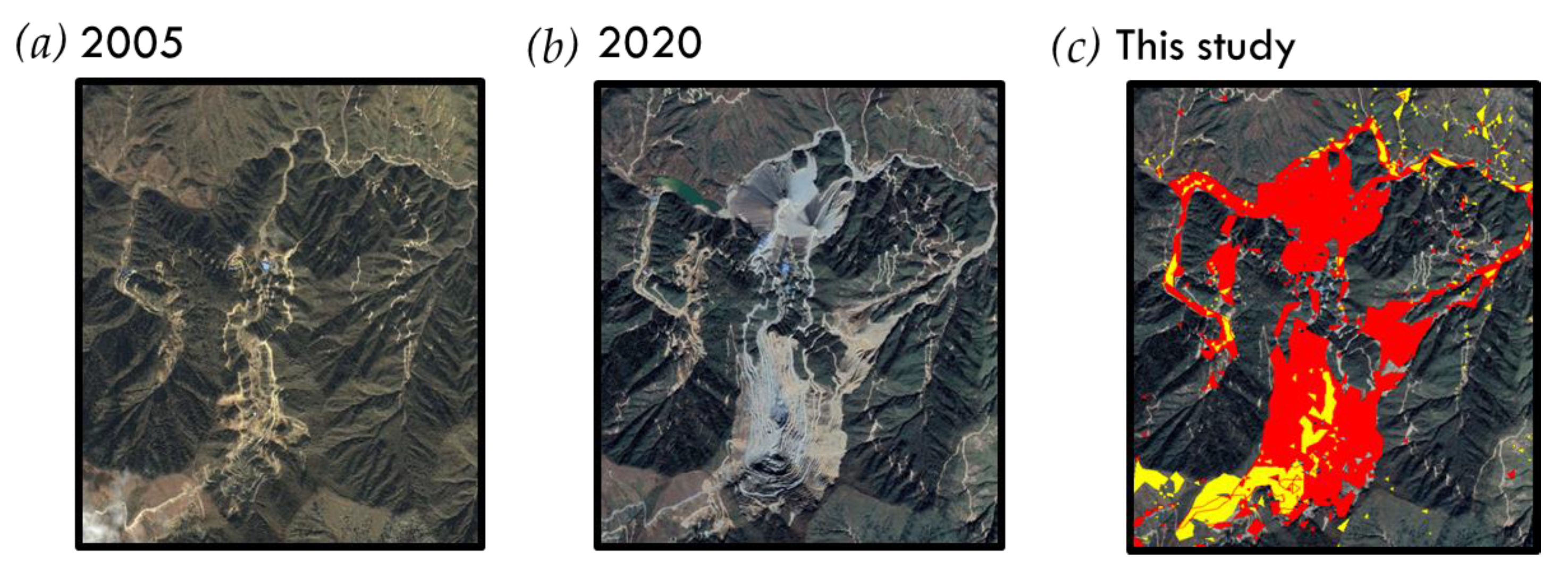
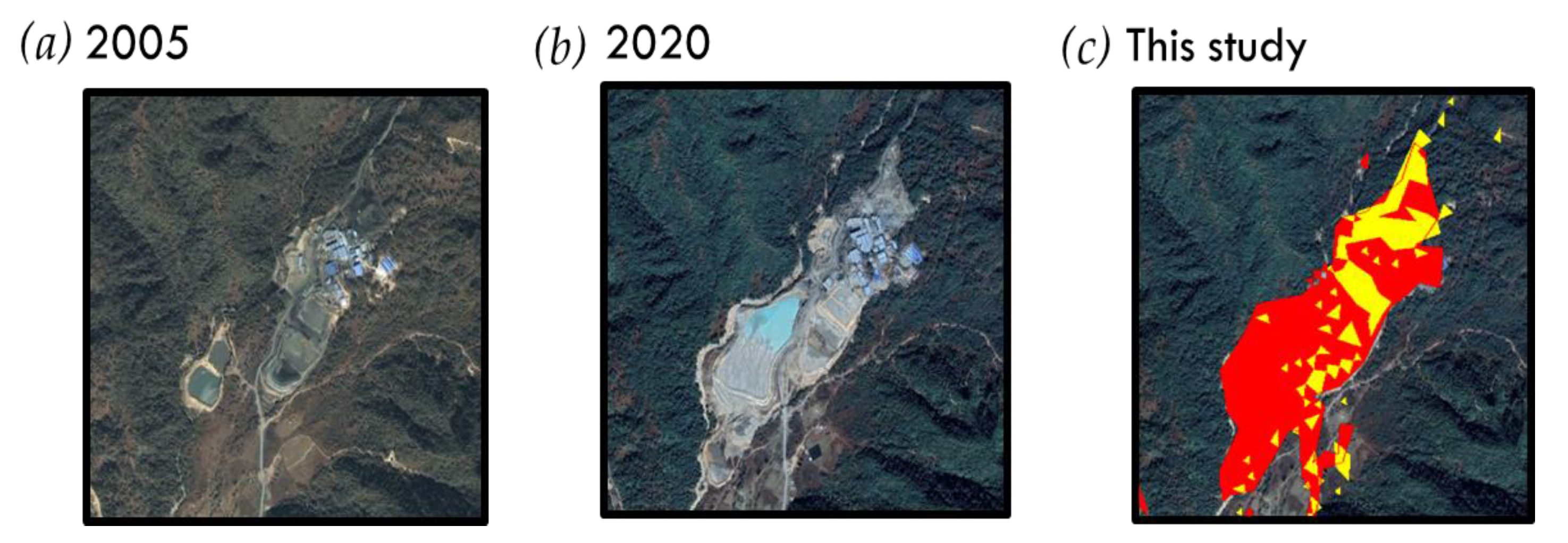
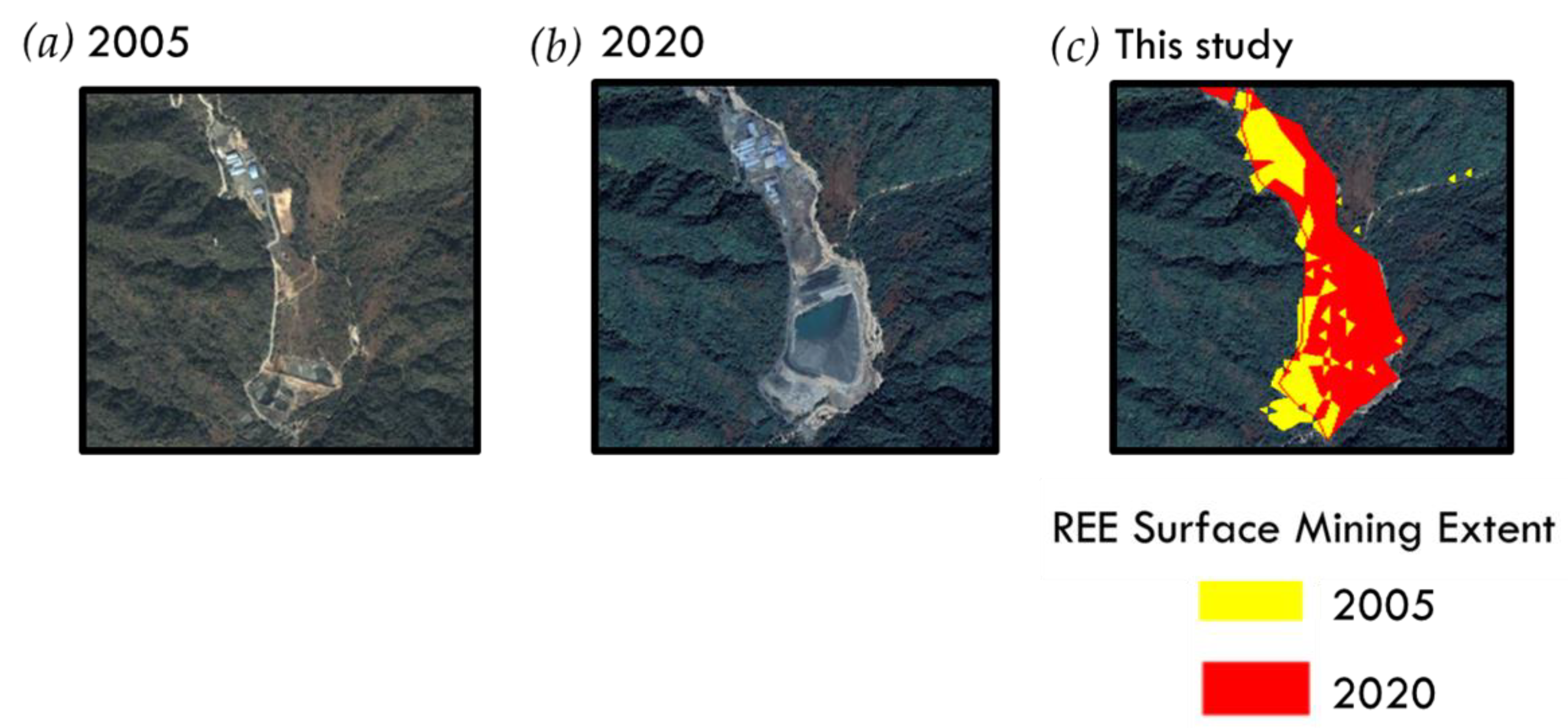
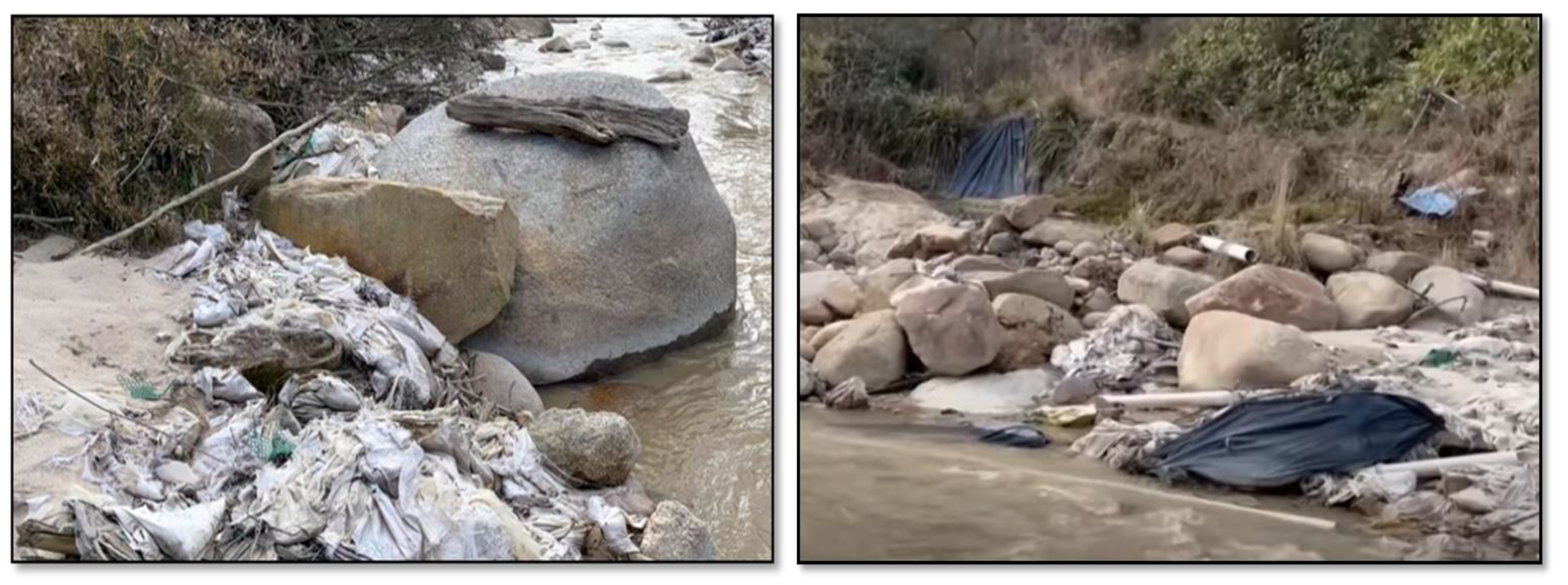
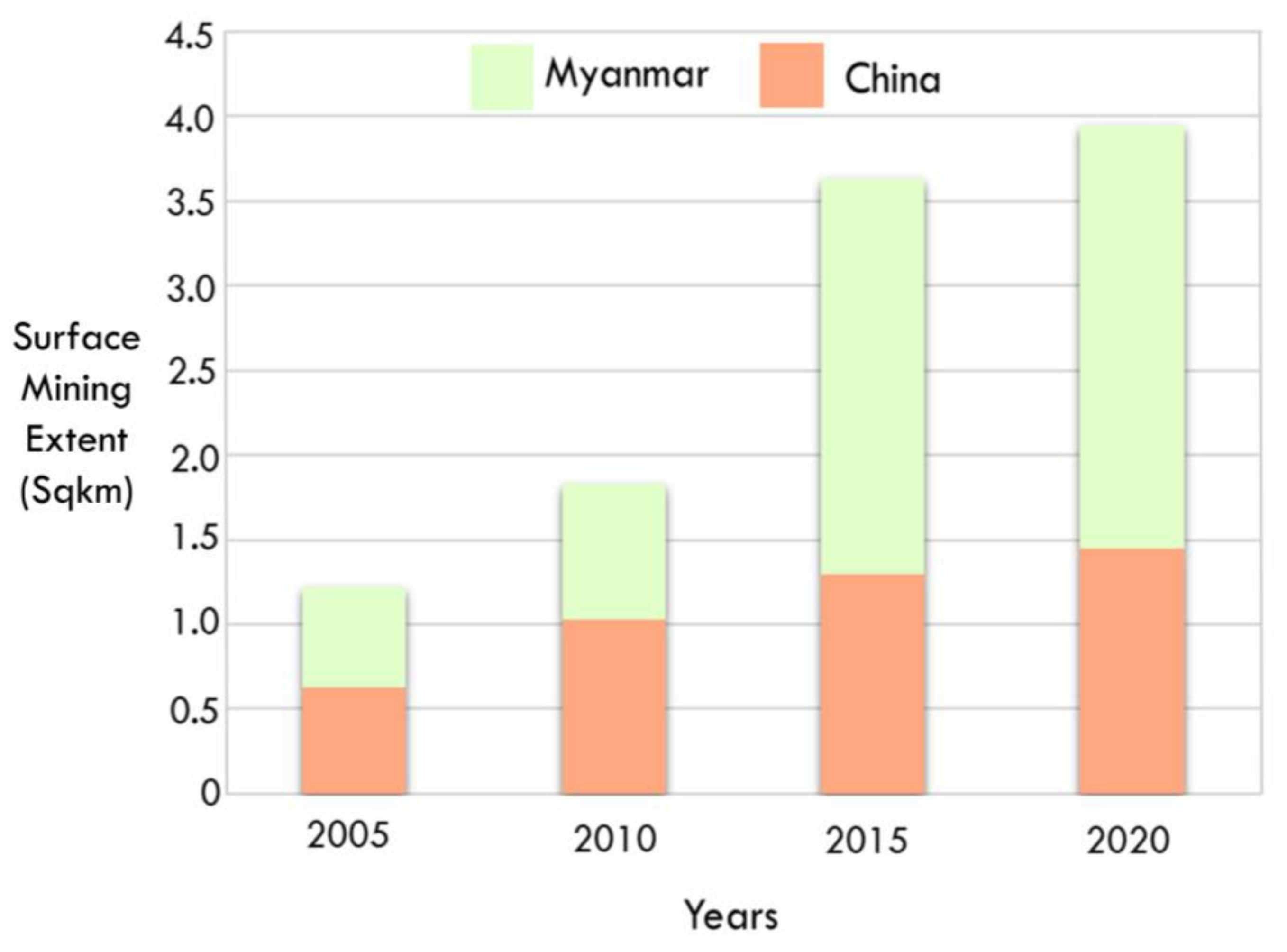
| Sensor | Band Number | Description | Bandwidth (µm) | Resolution (m) |
|---|---|---|---|---|
| Landsat 5 TM | 1 | Visible Blue | 0.45–0.52 | 30 |
| 2 | Visible Green | 0.52–0.60 | 30 | |
| 3 | Visible Red | 0.63–0.69 | 30 | |
| 4 | Near-Infrared 1 | 0.76–0.90 | 30 | |
| 5 | Near-Infrared 2 | 1.55–1.75 | 30 | |
| 6 | Thermal-Infrared | 10.40–12.50 | 120 | |
| 7 | Mid-Infrared | 2.08–2.35 | 30 | |
| Landsat 8 OLI | 1 | Coastal/Aerosol | 0.43–0.45 | 30 |
| 2 | Visible Blue | 0.45–0.51 | 30 | |
| 3 | Visible Green | 0.53–0.59 | 30 | |
| 4 | Visible Red | 0.64–0.67 | 30 | |
| 5 | Near-Infrared | 0.85–0.88 | 30 | |
| 6 | Shortwave-Infrared 1 | 1.57–1.65 | 30 | |
| 7 | Shortwave-Infrared 2 | 0.43–0.45 | 30 | |
| 8 | Panchromatic | 0.50–0.68 | 15 | |
| 9 | Cirrus | 1.36–1.38 | 30 | |
| 10 | Longwave-Infrared 1 | 10.6–11.19 | 100 | |
| 11 | Longwave-Infrared 2 | 11.5–12.51 | 100 |
| Sensor | Acquisition Date | Path/Row | Resolution |
|---|---|---|---|
| L5 TM | 13 January 2005 | 167/71 | 30 |
| L5 TM | 13 December 2010 | 161/71 | 30 |
| L8 OLI | 9 November 2015 | 161/71 | 30 |
| L8 OLI | 6 December 2020 | 161/71 | 30 |
| Category | Description |
|---|---|
| Mine area | Areas with surface mine operations, mine excavated areas, open-pit mine areas, mine wet and dry tailings, mine stockpiles, and mine operation buildings, including mine processing facilities. |
| Non-mine area | Areas with dense vegetation cover, sparse vegetation cover, mixed vegetation cover, and bare land. |
| Landcover Class | Mine Area | Non-Mine Area | Total | User’s Accuracy (%) |
|---|---|---|---|---|
| 2005 | ||||
| Mine area | 98 | 1 | 99 | 98.99 |
| Non-mine area | 2 | 181 | 183 | 98.90 |
| Total | 100 | 182 | 282 | |
| Producer’s Accuracy (%) | 98 | 99.45 | ||
| Overall Accuracy (%) | 98.94 | |||
| Kappa Coefficient | 0.9877 | |||
| 2010 | ||||
| Mine area | 98 | 0 | 98 | 100 |
| Non-mine area | 2 | 182 | 184 | 98.91 |
| Total | 100 | 182 | 282 | |
| Producer’s Accuracy (%) | 98 | 100 | ||
| Overall Accuracy (%) | 99.29 | |||
| Kappa Coefficient | 0.9918 | |||
| 2015 | ||||
| Mine area | 100 | 1 | 101 | 99 |
| Non-mine area | 0 | 181 | 181 | 100 |
| Total | 100 | 182 | 282 | |
| Producer’s Accuracy (%) | 100 | 99.45 | ||
| Overall Accuracy (%) | 99.64 | |||
| Kappa Coefficient | 0.9962 | |||
| 2020 | ||||
| Mine area | 99 | 0 | 99 | 100 |
| Non-mine area | 1 | 182 | 183 | 99.45 |
| Total | 100 | 182 | 282 | |
| Producer’s Accuracy (%) | 99 | 100 | ||
| Overall Accuracy (%) | 99.64 | |||
| Kappa Coefficient | 0.9958 | |||
| Landcover Change | Area Change (km2) |
|---|---|
| Mine area–Mine area | 0.57 |
| Mine area–Non-mine area | 0.64 |
| Non-mine area–Mine area | 3.20 |
| Non-mine area–Non-mine area | 53.33 |
| Sources, Environmental Impacts, and Pollution Pathways |
|
Disclaimer/Publisher’s Note: The statements, opinions and data contained in all publications are solely those of the individual author(s) and contributor(s) and not of MDPI and/or the editor(s). MDPI and/or the editor(s) disclaim responsibility for any injury to people or property resulting from any ideas, methods, instructions or products referred to in the content. |
© 2023 by the authors. Licensee MDPI, Basel, Switzerland. This article is an open access article distributed under the terms and conditions of the Creative Commons Attribution (CC BY) license (https://creativecommons.org/licenses/by/4.0/).
Share and Cite
Chinkaka, E.; Klinger, J.M.; Davis, K.F.; Bianco, F. Unexpected Expansion of Rare-Earth Element Mining Activities in the Myanmar–China Border Region. Remote Sens. 2023, 15, 4597. https://doi.org/10.3390/rs15184597
Chinkaka E, Klinger JM, Davis KF, Bianco F. Unexpected Expansion of Rare-Earth Element Mining Activities in the Myanmar–China Border Region. Remote Sensing. 2023; 15(18):4597. https://doi.org/10.3390/rs15184597
Chicago/Turabian StyleChinkaka, Emmanuel, Julie Michelle Klinger, Kyle Frankel Davis, and Federica Bianco. 2023. "Unexpected Expansion of Rare-Earth Element Mining Activities in the Myanmar–China Border Region" Remote Sensing 15, no. 18: 4597. https://doi.org/10.3390/rs15184597
APA StyleChinkaka, E., Klinger, J. M., Davis, K. F., & Bianco, F. (2023). Unexpected Expansion of Rare-Earth Element Mining Activities in the Myanmar–China Border Region. Remote Sensing, 15(18), 4597. https://doi.org/10.3390/rs15184597












